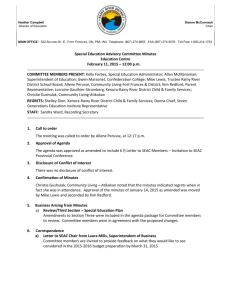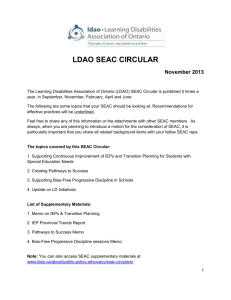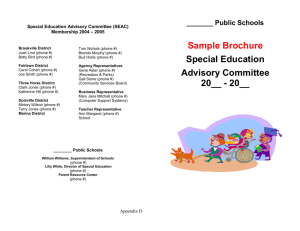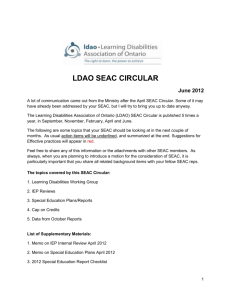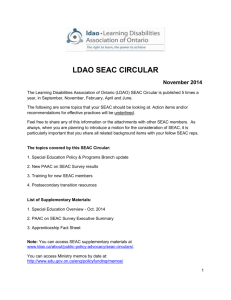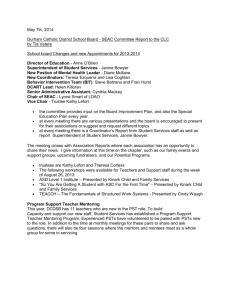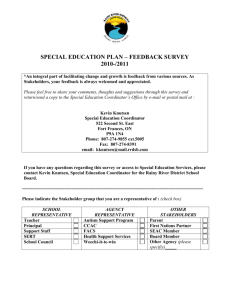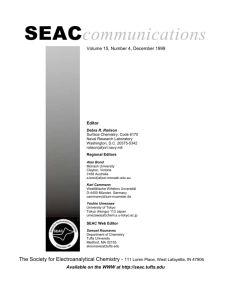SEAC Circular April 2011 - Learning Disabilities Association of Ontario
advertisement
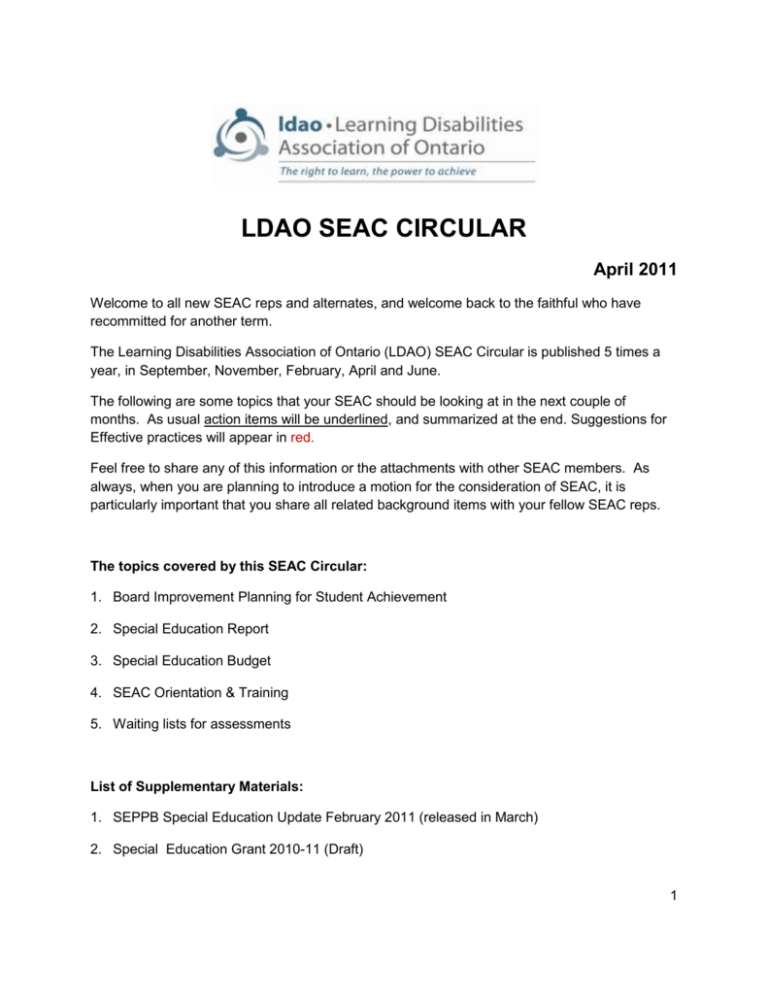
LDAO SEAC CIRCULAR April 2011 Welcome to all new SEAC reps and alternates, and welcome back to the faithful who have recommitted for another term. The Learning Disabilities Association of Ontario (LDAO) SEAC Circular is published 5 times a year, in September, November, February, April and June. The following are some topics that your SEAC should be looking at in the next couple of months. As usual action items will be underlined, and summarized at the end. Suggestions for Effective practices will appear in red. Feel free to share any of this information or the attachments with other SEAC members. As always, when you are planning to introduce a motion for the consideration of SEAC, it is particularly important that you share all related background items with your fellow SEAC reps. The topics covered by this SEAC Circular: 1. Board Improvement Planning for Student Achievement 2. Special Education Report 3. Special Education Budget 4. SEAC Orientation & Training 5. Waiting lists for assessments List of Supplementary Materials: 1. SEPPB Special Education Update February 2011 (released in March) 2. Special Education Grant 2010-11 (Draft) 1 1. Board Improvement Planning for Student Achievement SEACs should be involved in the development of their board’s Improvement Plan for Student Achievement over the school year. The following are some questions your SEAC can consider: -- Was SEAC consulted about the Board Improvement Plan (BIP) process and invited to be an active partner as the plan was developed? -- Was SEAC informed of who represented special education on the board team that developed the BIP? Has that person reported to SEAC? -- Was the SEAC invited to review the draft BIP and asked for its input? -- In determining SMART goals for the BIP was special education data considered? e.g. the number of identified students (IPRC); the number of students on an IEP; the number of students with special education needs on suspension, expulsion or otherwise not in attendance; the use of technology to support the learning of students with special education needs. -- How do your boards’ SMART goals address gaps in student learning and achievement in students with special education needs? LDAO SEAC reps are asked to send to LDAO a copy of their board’s latest Board Improvement Plan for Student Achievement. 2. Special Education Report SEAC should also be involved in the development of the Special Education Report (replacing the Special Education Plan) regarding the special education programs and services being offered by the school board. SEACs should review the Special Education Report developed last year and work on improving the wording and format of the report to make it as user-friendly for parents as possible. SEACs could also help plan for ways of sharing information in the Special Education Report with the wider school board community. 3. Special Education Budget The draft Technical Paper for school board funding for 2011-12 has been posted on the Ministry website (www.edu.gov.on.ca/eng/funding/1112/technical11.pdf), although the information contained in the document is not official until a regulation is officially made by the Lieutenant Governor in Council (a new funding regulation is made every year). The technical paper is very long, so I have attached the Special Education Grant section for you. The processes for special education funding are substantially the same as last year, although some of the individual numbers have changed. You will notice that the formulas for the Measures of Variability (MOV) and for the MOV Special Education Statistical Prediction Model are very complicated. If your SEAC has new members since last winter, you should ask 2 for a presentation to SEAC on the funding formulas and how they relate to your board’s special education budget. In the April and May meetings SEAC should be discussing their board’s special education budget forecast. 6. SEAC Orientation & Evaluation Several SEACs are using the PAAC on SEAC Handbook by going over a chapter at each SEAC meeting. 7. Waiting lists for assessments At least two school boards have been in the press recently because of teacher and/or parent concerns about waiting lists for professional assessments. From 2006-2008 the Ministry of Education funded a Student Assessment Project in partnership with the Ontario Psychological Association. One goal of the project was to reduce wait-times for students in JK to Grade 4 who required professional assessments, but in addition school boards were required to submit a plan to sustain assessment process improvements. SEACs reps should ask for an update on their board’s Assessment Capacity-Building Plan and the current state of wait times for professional assessments. However, PAAC has been hearing that some boards only approve a certain number of assessments to go onto the wait list, so SEAC should also ask for their board’s criteria for being on the wait list. ACTION ITEMS -- Review questions about SEAC’s role in developing your board’s Board Improvement Plan for Student Achievement. -- LDAO SEAC reps are asked to send to LDAO a copy of their board’s latest Board Improvement Plan for Student Achievement. -- Review the Special Education Report developed last year and work on improving the wording and format of the report to make it as user-friendly for parents as possible. -- Help plan for ways of sharing information in the Special Education Report with the wider school board community. -- If your SEAC has new members since last winter, ask for a presentation to SEAC on the funding formulas and how they relate to your board’s special education budget. -- In the April and May meetings SEAC should be discussing their board’s special education budget forecast. -- Ask for an update on your board’s Assessment Capacity-Building Plan and the current state of wait times for professional assessments, as well as the criteria for being on the wait list. Questions? E-mail: Diane Wagner at dianew@ldao.ca or call (416) 929-4311 Ex. 22 3
